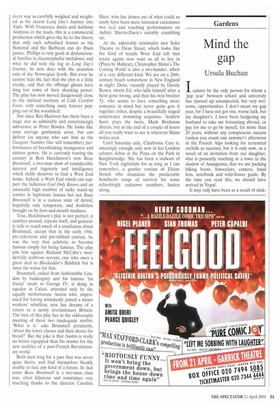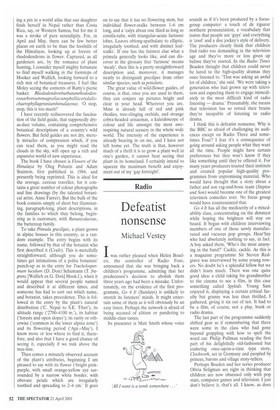Mind the gap
Ursula Buchan
Icannot be the only person for whom a 'gap year' between school and university has opened up unsuspected, but very welcome, opportunities. I don't mean my gap year, for I have not got one, worse luck, but my daughter's. I have been badgering my husband to take me botanising abroad, or pay for me to go by myself, for more than 20 years, without any conspicuous success (unless you count one summer's afternoon in the French Alps looking for terrestrial orchids as success), but it is only now, as a result of an invitation from our daughter, who is presently teaching in a town in the shadow of Annapurna, that we are packing hiking boots, binoculars, camera, hand lens, notebook and wild-flower guide. By the time you read this, we should have arrived in Nepal.
It may only have been as a result of stick
ing a pin in a world atlas that our daughter finds herself in Nepal rather than Costa Rica, say, or Western Samoa, but for me it was a stroke of pure serendipity. For, in April and May, there can be few better places on earth to be than the foothills of the Himalayas, looking up at forests of rhododendrons in flower. Captured, as all gardeners are, by the romance of plant hunting, I consider myself mighty fortunate to find myself walking in the footsteps of Hooker and Wallich, looking forward to a rich mix of botanical treasures. I feel like Moley seeing the contents of Ratty's picnic basket: Rhododendronbarbatumrhododenronarboreummagnoliacampbelliicorydalischaerophyllageraniumhimalayense. '0 stop, stop, this is too much?'
I have recently rediscovered the fascination of the field guide, that supposedly dryas-dust volume, containing comprehensive botanical descriptions of a country's wild flowers. But field guides are not dry, merely miracles of compression which, if you can read them, as you might read the clouds in the sky, will open up a rich and expansive world of new experience.
The book I have chosen is Flowers of the Himalaya by Oleg Polunin and Adam Stainton, first published in 1984, and presently being reprinted. This is ideal for the average, curious traveller, for it contains a great number of colour photographs and line drawings (by the talented botanical artist, Anne Farrer). But the bulk of the book consists simply of short but illuminating, paragraph-long, plant descriptions, in the families to which they belong, beginning as is customary, with Ranunculaceae, the buttercup family.
To take Primula gracilipes, a plant grown in alpine houses in this country, as a random example. The entry begins with its name, followed by that of the botanist who first described it (Craib). This is mercifully straightforward, although you do sometimes get intimations of a polite botanists' punch-up as in the entry for Trachelospermum lucidum (D. Don) Schumann (T. fragrans [Wallich ex G. Donl Hook.f.), when it would appear that several people named and described it at different times, and someone has had to sort out which name, and botanist, takes precedence. This is followed in the entry by the plant's natural distribution ('C. Nepal to S.E. Tibet'), its altitude range ('2700-4100 m.'), its habitat ('forests and open slopes'); its rarity or otherwise (common in the lower alpine zone') and its flowering period (`Apr.-May'). I know more or less where to find it, therefore, and also that I have a good chance of seeing it, especially if we trek above the tree-line.
Then comes a minutely observed account of the plant's attributes, beginning I am pleased to say with its flower ('bright pinkpurple, with small orange-yellow eye surrounded by a narrow white border, with obovate petals which are irregularly toothed and spreading to 2-4 cm.' It goes
on to say that it has no flowering stem, but individual flower-stalks between 1-6 cm long, and a 'calyx about one third as long as corolla-tube, with triangular-acute farinose lobes. Leaves oblong-spathulate to elliptic, irregularly toothed, and with distinct leafstalks'. If one has the faintest clue what a primula generally looks like, and can discover in the glossary that larinose' means 'mealy', then this is a pretty straightforward description and, moreover, it manages neatly to distinguish gracilipes from other similar species, such as petiolaris.
The great value of wild-flower guides, of course, is that, once you are used to them, they can conjure up pictures bright and clear in your head. Wherever you are. Mine is already full of red and pink rhodies, tree-clinging orchids, and strange cobra-headed arisaernas, a kaleidoscope of colour and life amongst the most aweinspiring natural scenery in the whole wide world. The intensity of the experience is already bearing in on me, and I have not left home yet. The truth is that, however much of a thrill it is to grow a plant well in one's garden, it cannot beat seeing that plant in its homeland. I certainly intend to squeeze the maximum benefit and enjoyment out of my 'gap fortnight'.



































































 Previous page
Previous page